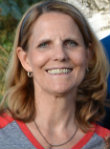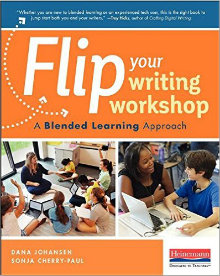Why and How to Flip Your Writing Workshop
Flip Your Writing Workshop
By Dana Johansen and Sonja Cherry-Paul
(Heinemann 2016 – Learn more)

Flip Your Writing Workshop nudges writing workshops to a new level through flipped mini-lessons, allowing more time for teachers to conference and meet with students. This is such a simple, elegant solution – allowing students to work at their own pace through video mini-lessons, while teachers focus on moving students forward through individual conferences.
Blended learning has been a part of my own classroom for various content areas, but not in a workshop approach. So I was interested in learning more.

What’s in the book
The book begins with an overview of flipped or blended learning. It is important to understand the pedagogy of flipped learning, and I appreciated the authors’ solid research and detailed history supporting its effectiveness.
Included at the beginning is a framework for lessons and screencast options, as well as where to store flipped lessons. Johansen and Cherry-Paul include important considerations about when and where students will use the lesson, and student engagement is a continuous underlying theme throughout all flipped writing workshop lessons.
Flipped learning helps students work at their own pace, set their own leading goals, and work with you to assess progress and set goals for the future. Flipped learning helps ensure that students can access instruction when they need it in order to continue moving forward.”
Each chapter follows a similar format around goal setting, lesson creation, method of delivery, and assessing progress:
- Why Do I wWant to Flip This Lesson?
- How Am I Going to Flip This Lesson?
- How will I Structure This Lesson?
- Where and When Will Students Use This Lesson?
- How Will I Know What My Students Have Learned?
The chapters are organized based on the purpose for writing. Each section delves into helping students generate ideas, draft initial writings, revise and edit works, or publish final pieces. A detailed framework is included in each chapter along with planning sheets. I had hoped these would be made available digitally, but unfortunately they can only be photocopied from the book.
Why use a flipped lesson?
One chapter example covers “Conquering the Blank Page” which begins with setting goals, asking yourself why you want to flip this lesson. Initially, the authors explain that their goal is to meet the needs of every learner in their classroom. Not every writer is at the same place in the process, so based on an observed need, a flipped lesson is created.
Technology can often be a barrier to trying something new, but Cherry-Paul and Johansen take you through a step-by-step approach with checklists, forms and video examples to begin the process.
A flipped lesson might be appropriate:
- With a small group or partnership with a shared need
- During a one-on-one conference
- With a student working independently
- As homework
- If a student is absent
Assessment is another key piece of the flipped writing workshop. Suggestions include providing guidelines for students, such as limiting the use of flipped lessons to one a day or expecting students to respond and reflect on their flipped learning. Tips and suggestions in the side notes offer practical hints and applications for greater engagement.
Helpful additions to each chapter are the QR codes linking to the video models of flipped lessons. When starting out, seeing an example of what a lesson looks like from a real classroom definitely is helpful. I actually skipped ahead in the book to view each of the videos to get a deeper understanding of how and where a flipped lesson would be implemented. As a visual learner, I also benefited from the many illustrations and examples interspersed throughout the book.
An easy read and continuing resource
Flip Your Writing Workshop contains an extensive amount of information for all teachers implementing a flipped writing workshop. The book is an easy read for busy teachers, but also a resource that will be referenced continuously.
Each chapter contains specific guidelines, helpful illustrations and tech tips, assuring you’ll be able to create a successful flipped workshop that will meet the needs of all students while allowing more time for important conferencing.
Sandy Wisneski is lead teacher at Catalyst Charter Middle School in Ripon WI. She is the district webmaster, a tech mentor and yearbook advisor, as well as IE mentor. Over the past 40 years Sandy obtained her masters in reading, became certified as a Flat Classroom Teacher, a Common Sense Certified Educator and a BrainPOP Certified Educator. She’s been to summer camp twice – the Honeywell Educators @ Space Academy (2014) and the Honeywell Green Boot Camp in San Diego (2016). She enjoys challenging students to “take ownership” for their learning and to be effective digital citizens in the world. Find Sandy @stampcat2, Stampcat2TechnifiedBlog, and CatalystChannelBlog.


































